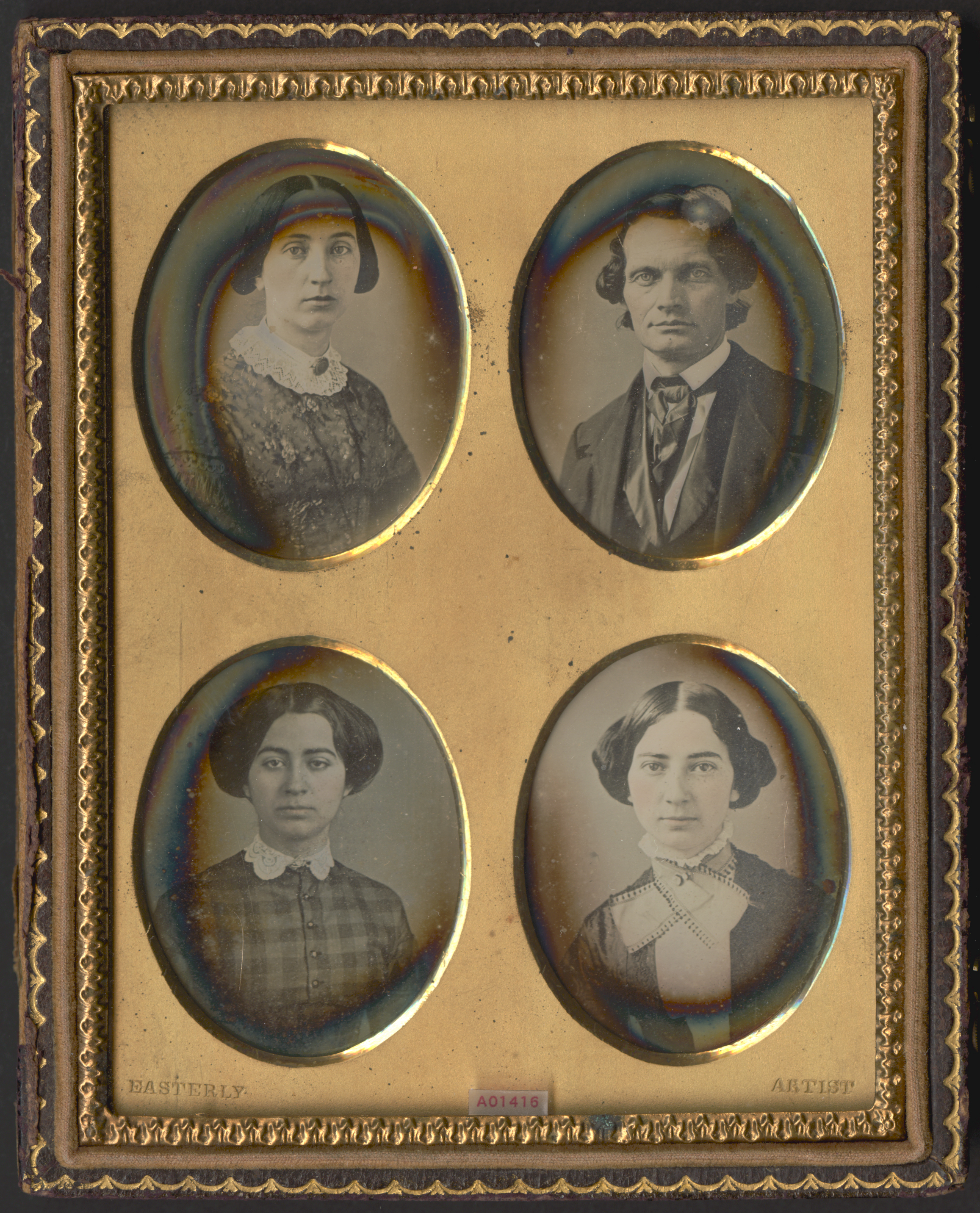Thomas M. Easterly Gallery
Related Resources
In 2009, the Clements Library acquired a group of daguerreotypes and ruby-glass ambrotypes that presumably had belonged to the Cahill family of Minneapolis in the mid-nineteenth century. Sarah Melinda “Linda” Bailey Cahill, the matriarch, was a frequent subject of the many portraits. Also depicted were Linda’s sisters–Margaret Bailey Townshend, [Anna] Miriam Bailey Easterly, and Mary Bailey–her husband, William Frank Cahill, and several of their young children. The family had as their portraitist one of the most renowned and artistic daguerreotypists of all time, Miriam’s husband, Thomas Easterly. Only the daguerreotypes bearing the characteristic “Easterly, Artist” mats, or Easterly’s handwriting on the verso, can be attributed to Easterly with absolute certainty. However, a number of the un-attributable daguerreotypes bear the characteristics of an Easterly work, including partiucular poses that Easterly favored, a general lack of props and embellishments, and a rare and startling rapport between subject and artist that strikes the viewer immediately.
All images below are confirmed Easterly works, unless otherwise noted.
This portrait of (Anna) Miriam Bailey Easterly, dated August 1849, may be the earliest of the Easterly daguerreotypes in the collection. Easterly produced it nearly a year before his marriage to Miriam, in June 1850. It is unknown how Thomas and Miriam met, but it may have been through a sitting like this one.
This daguerreotype stands out from the rest of Easterly’s known work due to its finely painted flowers, an embellishment that Easterly was reluctant to add in his other pictures, but one which he executed with great skill. Inside the case, behind the daguerreotype is written in Easterly’s hand: “Equal’d by few,” revealing Easterly’s burgeoning admiration for Miriam. Easterly signed the work “T.M. Easterly, Daguerrean.”
This daguerreotype portrait again shows Easterly’s wife, Miriam. Thought to have been taken in 1850, around the time of their June marriage, it may show Miriam in her wedding ensemble. The white wedding dress had only captured the popular imagination a decade before, with Queen Victoria’s choice of a white, lacy dress for her wedding ceremony to Albert, and options for bridal garments varied widely. Miriam appears to wear a patterned dress with a white wrap.
In this unusual composite portrait, Easterly juxtaposes (clockwise from top left): Miriam, himself, and two of Miriam’s sisters, (Sarah) Melinda Bailey Cahill, and Mary Lang Bailey. The three sisters, along with additional siblings, Margaret and Adoniram, had been orphaned in 1835. Despite scattering across the Midwest, they remained close to one another, through letters, visits, and even the exchange of hairwork jewelry.
This Easterly daguerreotype depicts Mary Lang Bailey, the youngest of the Bailey sisters, who was born in 1833. Mary lived to be only 21–she died of typhoid fever during a visit to her sister Melinda in 1854. Although she passed away in Minnesota, her home for most of her life was in St. Louis, where Thomas and Miriam Easterly lived.
Also in the collection is a carte de visite copy of this daguerreotype, made around 1865, ten years after Mary’s untimely death.
This daguerreotype is the earliest known portrait of (Sarah) Melinda Bailey (1830-1889), probably taken around 1849. Melinda married a miller and moved to Minnesota in 1853. Although this daguerreotype lacks any identification of its photographer, it shares with Easterly’s body of work a finely-attuned sensitivity to its subject.
Taken around 1850, this daguerreotype shows Margaret Bailey, who later became the wife of Norton Strange Townshend. Margaret was the oldest of the Bailey sisters, and by teaching at girls’ schools, she provided the funds to educate her three younger sisters, all of whom were quite cultured. Her devotion to her career and concerns about providing made her the last of them to marry, in 1854. This daguerreotype may or may not have been made by Easterly, but we know from correspondence that Easterly had at some point taken a “Maggie Bailey picture.” Whoever the photographer, he manages to capture something of her practicality and dutifulness, as well as her intelligence.
These daguerreotype views of Niagara Falls were probably taken in 1853, when Easterly briefly returned to the east from St. Louis. During this period, he traveled with a Scottish photographer, John Werge, producing a number of images of the natural wonder. Easterly’s images of Niagara are highly unconventional. They are neither ordinary tourist pictures, nor strictly romantic views of nature. Instead, a number of Easterly’s images show the encroachment of industry and man-made structures on the Falls. This theme runs throughout Easterly’s work, for example, in his depiction of the destruction of St. Louis’ Native American mounds, captured in images now at the Missouri Historical Society.
Easterly also focuses on the sublime-ness of nature in many of his works, as in the image below, where men are dwarfed by the enormity of the Falls.
This portrait of Wiliam Frank Cahill (1830-1886) was taken by Easterly around 1855, soon after Cahill’s marriage to (Sarah) Melinda Bailey in 1853. Cahill was a successful miller and recent Irish immigrant.
This later portrait of Miriam, probably taken around 1860 by Thomas Easterly, shows Miriam in an atypical pose–nearly in profile, unlike the usual 3/4 orientations seen above. This turning away from the camera creates a distance between subject and viewer, which sets this image apart from more engaging portraits of Miriam.
Front and center in the image is Miriam’s sewing basket, topped by a thimble. Miriam reportedly supplemented her husband’s income by taking in sewing. Her contributions became increasingly important as daguerreotypes fell out of style and were replaced by cheaper and faster formats, which Easterly viewed with disdain and refused to embrace. This daguerreotype serves as Easterly’s acknowledgement of his wife’s role as an earner and craftswoman.










